" They will die and we will win"
Ceriñola marks the beginning of the hegemony that Spain imposed on European battlefields until the defeat of Rocroi in 1643. The Great Captain stands out as a military genius, sowing death among the French and changing the course of the world.
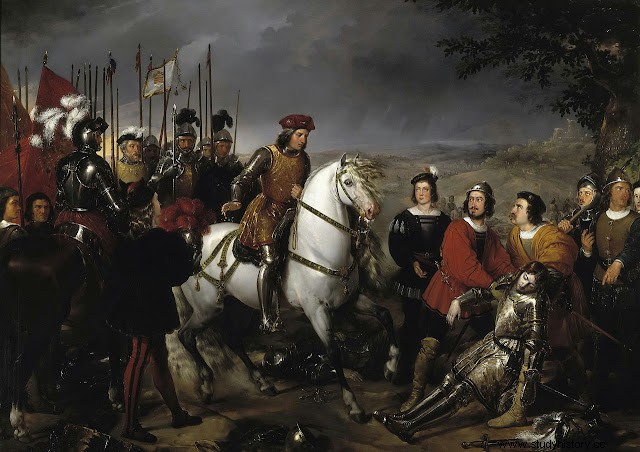 The Great Captain contemplating the corpse of the Duke of Nemours, commander of the French army at the Battle of Ceriñola.
The Great Captain contemplating the corpse of the Duke of Nemours, commander of the French army at the Battle of Ceriñola.The Italian wars, also known as "the great Italian wars" and "the Italian wars", were a series of conflicts that took place between 1494 and 1559 that involved, on different occasions, the main states of Western Europe:France, Spain, the Holy Roman Empire, England, the Republic of Venice, the Papal States and most of the Italian city-states, as well as the Ottoman Empire.
Initially it was a dynastic dispute over France's hereditary rights to the Duchy of Milan and the Kingdom of Sicily Citerior, but the wars quickly turned into territorial and power struggles. power between the different participants, which were marked by games of alliances, counter-alliances and frequent betrayals.
After the unexpected rupture by the French of the Treaty of Granada, by which the Kingdom of Naples was divided between Spain and France, the Duke of Nemours forced the hosts of the Great Captain to beat a retreat and take refuge in the city of Barletta, in 1502. Waiting for reinforcements, the Spanish troops dedicated themselves to carrying out night raids and ambushes against the French, a tactic inherited from the war in Granada and which exasperated the Frenchmen who were not used to this type of confrontation. During that wait, singular duels were organized between Spanish and French knights. The most famous took place on September 21, 1502, and in it eleven French knights fought against eleven Spaniards for more than 6 hours (Barletta Challenge). The result was very favorable to the Spanish, resulting in one knight killed, another surrendered and 9 wounded on the French side, and one knight surrendered and two wounded on the Spanish side.
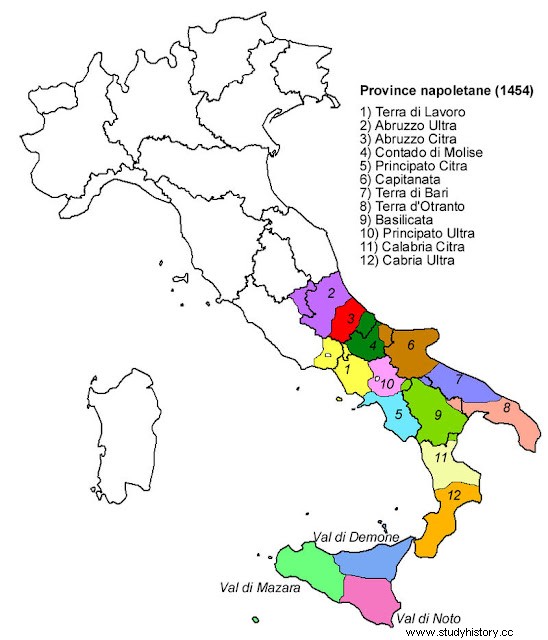 Provinces of the ancient kingdom of Naples
Provinces of the ancient kingdom of NaplesFinally, after the victory of the Spanish squadron of Admiral Juan de Lezcano over Admiral Prijan's French at the battle of Otranto, the Great Captain was able to reinforce himself with German lansquenets, with whom he launched the offensive in the spring of 1503. In order to advance as quickly as possible, the Spanish general ordered that each knight transporting an infant on the back of his horse, which, given the sense of honor of the time, caused a barrage of protests from the soldiers. The Great Captain immediately silenced the complaints by setting an example himself.6 Thanks to this action, unprecedented for that time, the Spanish army managed to reach the small town of Ceriñola with enough time to carefully prepare the defense against the imminent French attack. Quickly, the Spanish general ordered a ditch to be dug and, with the extracted earth, to build a parapet on which sharp stakes were anchored. When finally the troops of the Duke of Nemours approached Ceriñola, the Great Captain had already prepared the defense and defined a strategy.
Ceriñola is located on a hill, on whose slope there were many vineyards and at the end of them, a ravine The Great Captain established his camp at this site; he ordered the ravine to be enlarged and its edge raised to form a trench garnished with stakes and iron hooks to disable the enemy cavalry.
Battles of Hispania Official Store
The Spanish forces were formed mainly by infantry, composed of arquebusiers, crossbowmen, chestguards, and pikemen. As for the cavalry, it was conspicuously scarce compared to other armies, and was made up of light cavalry and heavy cavalry. The available artillery consisted of about 13 pieces arranged on a small hill that rose behind the moat and the slope (formed in turn by the earth extracted when digging the moat) that protected Ceriñola.
The arquebusiers, in the front line, were arranged in two groups of about 500 men each behind the slope that followed the dug ditch and in several trenches located in front of the ditch. Behind them, and in the center, were grouped about 2,500 German pikemen. On both sides of the pikemen, two groups of about 2,000 chestguards and crossbowmen each had been placed. Behind the coseletes and towards the flanks, the two groups of about 400 heavy cavalry men were placed, commanded by Próspero Colonna and Pedro de Mendoza.
Finally, on the hill where the artillery was located, a group of 850 light cavalry men, led by Fabrizio Colonna and Pedro de Pas, both under command immediate view of the Great Captain, who had a complete view of the battlefield from there. The mission of the light cavalry was to prevent the French troops from overwhelming the Spanish infantry in case they were able to break through the defenses and cross the slope.
Therefore, although Gonzalo Fernández de Córdoba was facing superior forces, he had achieved many strategic advantages thanks to his careful preparation for the battle, since he had occupied the heights of Ceriñola, and entrenched his soldiers with palisades, moats, and stakes. In addition, his artillery was also better placed than the French.
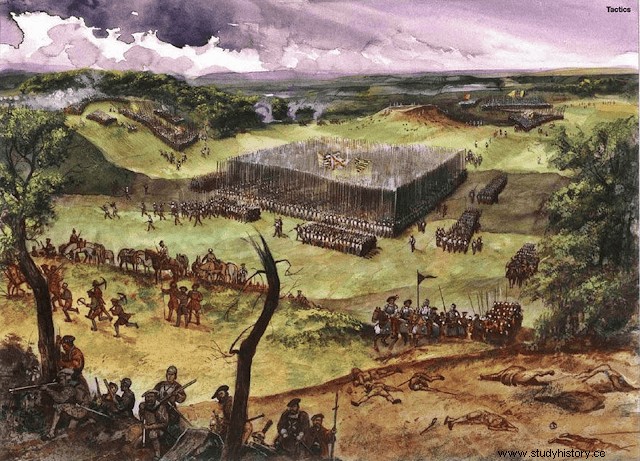 Spanish Tercio formed a squadron
Spanish Tercio formed a squadronThe French forces continued to hold an almost feudal concept of battle, with a preponderance of heavy cavalry charges, and with a high number of mercenaries (in this case Swiss), but, at the same time, they had more artillery than the Spanish. This paradox would be constant in the first half of the 16th century in all French armies.
In the case of Ceriñola, the French troops, commanded by the Duke of Nemours, were grouped into four large blocks. In the vanguard was the heavy cavalry, separated into two groups of about 1,000 horsemen each. In it, in immediate command, was the Duke of Nemours himself. Behind them stood 3,000 Swiss mercenary pikemen, commanded by Chadieu. Immediately after, in another large group of 3,000 men, the Gascon infantry was located. At the head of the infantry were the 26 artillery pieces they had. Finally, the light cavalry, commanded by Yves d'Allegre, waited behind them all, facing the left flank in the direction of the troops' advance.
When the French army arrived in the vicinity of Ceriñola, seeing the Great Captain the enormous advantage that the French forces had, he told García de Paredes that on that day they would be victorious or they would be left dead in the field like good soldiers, "that a good death honors life" , to which Samson from Extremadura replied:"They will die and we will win" .
The Duke of Nemours had conceived the battle as a brutal clash of his heavy cadre of knights and infantrymen, certain that with those forces he would literally sweep the Spanish positions. The Great Captain, on the other hand, had arranged a different tactical approach, giving special importance to the use of the terrain and the use of the arquebusiers.
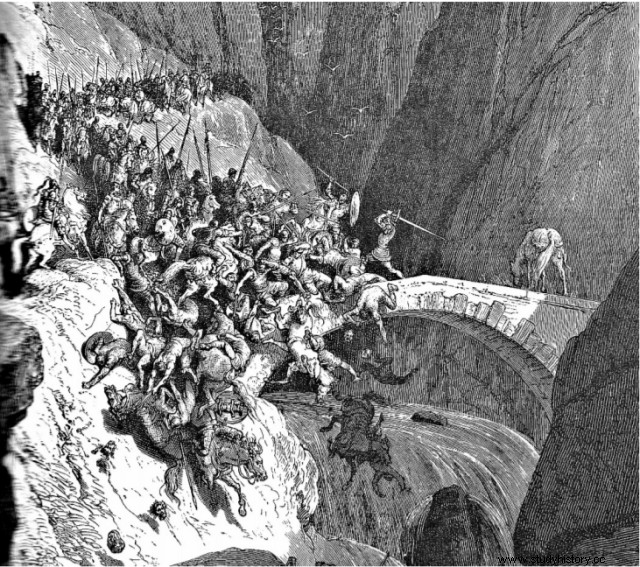 Diego García de Paredes crushing French troops on the Garellano river bridge
Diego García de Paredes crushing French troops on the Garellano river bridgeOne of the most surprising features of the battle, was the extreme rapidity with which it developed. From the first French charge to the surrender, barely an hour passed.
The Grand Captain, aware of the enthusiasm of the French for cavalry charges, devised a stratagem that consisted of provoking a charge and attracting the French cavalry to the range of the artillery and the Spanish arquebusiers, to inflict from the first moment the greatest possible damage to the enemy with the minimum cost. Thus, as evening began to fall, the Spanish cavalry came out into the open and simulated a charge against the French.
After a brief skirmish, the Spanish feigned retreat, pursued by the French heavy cavalry, who had previously Upon reaching the ditch and the embankment, he unexpectedly found the vanguard trenches in which part of the arquebusiers were crouched, who immediately opened fire, as did the artillery. This caused a momentary retreat of the French cavalry, which then launched parallel to the slope and to the left, trying to find a way to enter the parapets of the Spanish right flank. During this route, the French cavalry was destroyed by the fire of the Spanish arquebusiers, dying at that moment the Duke of Nemours, who was hit by three shots.
The entire French Army then went into battle, placing their artillery at the forefront of the infantry, and the three remaining large blocks arranged diagonally with respect to the ditch and the embankment that protected the Spanish troops.
In the midst of the battle, the Spanish artillery was rendered useless when all the gunpowder accidentally exploded . The Great Captain, witness to the disaster of his artillery, immediately harangued his troops saying «Cheer up! These are the lights of victory! In a fortified field we don't need cannons!”
The French infantry then engaged the Spanish troops in combat, but they were decimated by the incessant fire of the arquebusiers. The head of the Swiss pikemen, Chadieu, also fell dead. When the proximity of the French infantry was too dangerous for the arquebusiers, the Spanish general ordered them to withdraw while ordering the German pikemen to advance, who engaged the Swiss and Gascons in close combat, finally repulsing them.
Finally, and before the French disaster, the Great Captain ordered all his troops to leave the defensive positions and launch the attack. The French infantry was then surrounded by the crossbowmen, arquebusiers, coseletes and by the Spanish heavy cavalry, suffering a large number of casualties. The Spanish light cavalry in turn launched against the French light cavalry, commanded by Yves d'Allegre, who was forced to flee. Given this circumstance, the Spanish light cavalry also charged against the French infantry. The French troops, faced with the tremendous punishment they were suffering, ended up surrendering.
During the battle, the Spanish arquebusiers fired a total of about 4,000 shots.
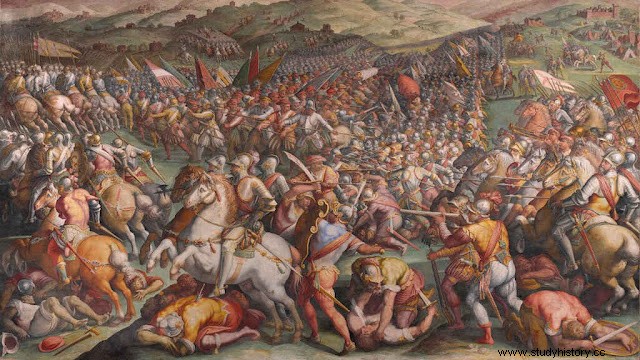 Spanish Tercios in full battle
Spanish Tercios in full battleThe French defeat in Ceriñola, together with the battle of Seminara occurred the The previous week, in which the Spanish troops of Fernando de Andrade and Hugo de Cardona defeated the French Army of D'Aubigny in Calabria, meant a change in the situation of the war in Naples:from this moment it would be the Spanish forces who they would take the initiative in the course of the war, driving the French back to the north.
From a military point of view, it represented a revolution in battle tactics, and would lay some of the foundations for modern warfare. For the first time in history, an infantry armed with arquebuses managed to defeat the cavalry in the open field. The Spanish general applied a system of containment-counterattack, based on the use of firearms with the purpose of fixing and disrupting the French cavalry charge, also adding a correct choice of the occasion and the terrain (including its preparation) where present battle. In addition, the Great Captain demonstrated once again that an army made up of smaller and more independent units provided mobility that was a decisive advantage in battle with respect to armies grouped in larger blocks, such as the one commanded on that occasion by the Duke of Nemours. Despite the fact that until then the Spanish armies, like those of other European powers, were based on the massive use of cavalry, a legacy of the wars of the Reconquest, this new infantry was structured in units created by the Great Captain and called coronelías, which, once their great effectiveness in battle had been proven, would be the seed of the famous Spanish Tercios during the following decades.
Ceriñola marks the beginning of the era of the infantry, which would remain the preponderant force in any army in Europe for more than four centuries, well into World War I.
| Date | April 28, 1503 | |||
|---|---|---|---|---|
| Place | Ceriñola (Puglia), Italy | |||
| Coordinates |  41°16′00″N 15°54′00″E 41°16′00″N 15°54′00″E | |||
| Result | Spanish victory | |||
| Belligerents | ||||
| ||||
| Commanders | ||||
| ||||
| Forces in combat | ||||
| ||||
| Lowers | ||||
| ||||

 Kingdom of France
Kingdom of France Hispanic Monarchy
Hispanic Monarchy